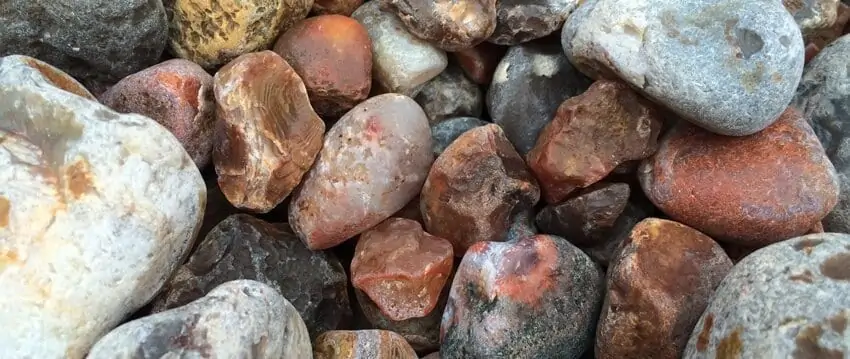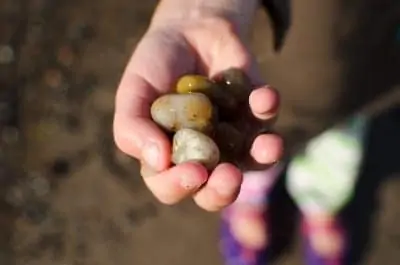
Rockhounds and casual beachcombers alike know the term “Lake Superior Agates”. For many, finding one is a central part of their North Shore vacations. Entire Facebook groups are dedicated to those on the hunt for the elusive Lake Superior Agate. But what are they? Why are they so special? And, most importantly, where can I find them? We answer all of that, and more, right here!
The Formation of the Lake Superior Agates
Lake Superior Agates are a specific kind of stone that was formed by volcanic activity along the North Shore 1.2 billion years ago. Gas pockets in the molten lava filled with mineral deposits like ferric iron, quartz, or calcite as the years passed by. The pockets that were filled with quartz-rich deposits gradually crystallized into concentric bands (known as chalcedony) to form agates. Over time, (we’re talkin’ a billion years) the agates were freed by water and ice from the lava rocks that they were buried in. Now, you’ll find them scattered along the North Shore.
Agates are red, orange, and (sometimes) yellow and are very different from other types of agates found throughout the world. The oxidation of iron created beautiful and iconic red colors. The color that appears between an agate’s band is determined by the amount of oxidation that took place when the rock formed.
Agates range significantly in size with most of them being small, pea-sized stones. However, some weigh over 20 pounds (they’re about the size of a bowling ball)! There are a few different types of Lake Superior Agates, with the most common being the fortification agate which displays the well-known banding pattern.
How to Find Lake Superior Agates
 When you’re searching for agates among other rocks, you’ll want to look for a few clues:
When you’re searching for agates among other rocks, you’ll want to look for a few clues:
- Rocks that appear shinier and more translucent than others around it
- Rocks with colored bands
- Rust-red or yellow-stained rock surfaces (caused by iron oxide)
- The surface has a pitted texture
Many people find it easier to find agates when the rocks are wet- so walk along the shoreline closer to the lake and shift the rocks with your foot to reveal the wet rocks under to the dry top layer. Others have found luck by searching out the colored bands further back amongst the dry rocks. Really, there isn’t a right or wrong way to hunt for agates.
Where to Find Lake Superior Agate’s on the North Shore
Agates can be found along Lake Superior’s North Shore. They can also be found near inland near lakes, almost any place with gravel or exposed rocks and the gravel banks of nearby streams and rivers. Lake Superior beaches along Highway 61 that we recommend for agate hunting include:
- Brighton Beach, Duluth
- Burlington Bay, Two Harbors
- Flood Bay Wayside Rest (1 mile east of Two Harbors)
- Cut Face Creek Wayside Rest (14 miles north of Lutsen)
- The Mouth of Devil Track River (3.7 miles east of Grand Marais)
- Five Mile Rock Beach (5 miles east of Grand Marais)
- The Mouth of the Kadunce River (12.7 miles east of Grand Marais)
- Paradise Beach (13 miles east of Grand Marais)
- Brule River (14.5 miles east of Grand Marais)
- Horseshoe Bay (24 miles east of Grand Marais)
And, even if you do not find an agate during your hunt, there are many other great stones to be found along Lake Superiors’ shorelines. Even sea glass! For kids, it’s a great way to learn a little about local geology while on vacation.
Fun Fact!
Back in 1969, the Lake Superior Agate became Minnesota’s state rock. It beat out other types of rocks like Binghamite yellow silkstone, Thomsonite, and Pipestone.
